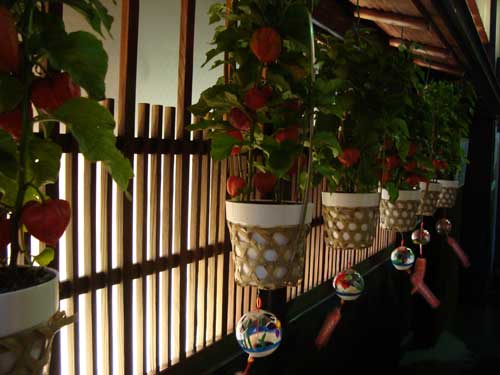
In Kagurazaka.

On a drizzly day last week, I met an English landscape architect and her architect husband at Canal Cafe on the Soto-bori moat (外濠) at Iidabashi station. I often pass this moat riding the Chuo and Sobu JR trains, but it was lovely to have a meeting alongside the water. The birds seemed happy in the light rain. (UPDATE: The birds are cormorants, or in Japanese u (鵜). They are fish-eaters).

We had a long conversation about conservation agriculture and energy efficient, low-income housing. After enjoying the moat, we took a walk through Kagurazaka and explored its many alleys. I love this neighborhood, and it’s fun to see this historic entertainment district during the day. I love how inward focused the bars and restaurants are, with straw blinds and plants preserving privacy for their customers.

As I posted yesterday, I observed the Awa Odori (阿波踊り) dance festival in Kagurazaka (神楽坂), a quiet hillside neighborhood in Shinjuku with many old buildings and known 100 years ago as an entertainment district with geishas.
The Awa Odori is a popular mid-summer festival that began in the 16th century in Tokushima in Shikoku prefecture. Fifteen or more dance troops, including all ages and children, climb up the Kagurazaka hill on the main street to the music of shamisen lute, taiko drums, shinobue flutes, and kane bells. The dancing is broadly comedic, with exaggerated swagger suggesting drunken freedom. Lanterns line the road, and are carried by dancers.
Troops are formed by government pension workers, the local post office, neighborhood associations, schools and businesses. Despite rainfall, the dancers and large crowds of onlookers were enthusiastic. The lyrics according to Wikipedia are:
踊る阿呆に (Odoru ahou ni) The dancers are fools
見る阿呆 (Miru ahou) The watchers are fools
同じ阿呆なら (Onaji ahou nara) Both are fools alike so
踊らな損、損 (Odorana son, son) Why not dance?
There is also a call and response that reminded me of other street festivals, particularly the omatsuri (お祭) when portable shrines (omikoshi, お神輿) are carried through the streets. The words are without meaning but coordinate the movement: “Yattosa, yattosa”, “Hayaccha yaccha” and “Erai yaccha, erai yaccha”, “Yoi, yoi, yoi, yoi”.
Street festivals, by occupying public streets and bringing the community together to celebrate, seem a central part of Tokyo Green Space. By bringing together workers, students, kids, elderly, business owners, neighbors and tourists, street festivals connect people to history and each other.
I was reminded of a similar mix of public celebration and history the following night when I attended the Sumida River fireworks (hanabi, or はなび). It was startling how many young people wore traditional yukata and geta (well, some of them accessorized the old with flip flops or high heels).

The last weekend of August, there is an even bigger Awa Odori in Koenji. Please click the link below to see more videos and still photos of the Kagurazaka event.

These Chinese lantern flowers were hanging in baskets with ornaments outside a restaurant in Kagurazaka (神楽坂) during the summer Awa Odori (阿波踊り) dance festival. It’s great to see living plants celebrating a street party full of music, dancers of all ages, comedy and many observers. I’ll post more about the Awa Odori soon.